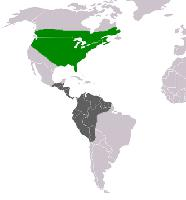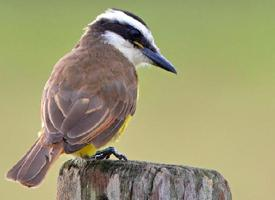
State of endangerment
| Endangered |
Animal description
The Eastern Kingbird (Tyrannus tyrannus) is a striking passerine bird that belongs to the Tyrannidae family, commonly referred to as tyrant flycatchers due to their aggressive nature, especially in defending their territories. Native to the Americas, this bird is highly migratory, breeding across North America, from the Rocky Mountains eastward to the Atlantic coast, and wintering in the forests of South America.Characterized by its distinctive plumage, the Eastern Kingbird has a sleek, predominantly black and white appearance. The adult bird typically measures around 19 to 23 cm (7.5 to 9 inches) in length, with a wingspan ranging from 33 to 38 cm (13 to 15 inches). The upper parts of its body are a deep, glossy black, which contrasts sharply with the pure white underparts. One of its most notable features is the white tip on the tail, which is especially visible in flight. The bird's head is adorned with a concealed crown of yellow, orange, or red feathers, which can be exposed during aggressive encounters or courtship displays.
The Eastern Kingbird possesses a sturdy body, a large head, and a broad, straight bill typical of flycatchers, adapted for its insectivorous diet. Its diet primarily consists of flying insects, which it catches in mid-air with remarkable agility. On occasion, it may also consume fruit, especially during the winter months or in its wintering grounds.
This species exhibits a fascinating behavior known as "hawking," where it flies out from a perch to snatch insects in midair before returning to its original or nearby perch. Its flight is characterized by a series of rapid wing beats followed by a glide, a pattern that is quite distinctive among birds.
Breeding pairs of Eastern Kingbirds are monogamous and are known for their fierce territoriality during the breeding season, which typically runs from May through July. They construct their nests in trees or shrubs, often near water, and both parents are involved in nest building, incubation of the eggs, and feeding the young. The nest, made of twigs, grass, and lined with finer materials, hosts a clutch of usually three to five creamy white eggs, speckled with brown.
Communication among Eastern Kingbirds involves a variety of vocalizations, from sharp, electric "kit" calls to a more complex, chattering song used in territorial defense and courtship. Despite their aggressive demeanor towards intruders and predators, including much larger birds, they are generally tolerant of humans and can often be observed in open habitats such as fields, parks, and along watercourses.
As a species, the Eastern Kingbird is currently classified as Least Concern by the International Union for Conservation of Nature (IUCN), indicating that it does not face immediate threats of extinction. However, like many migratory birds, it is potentially vulnerable to habitat loss and changes in climate that could affect its breeding and wintering grounds. Conservation efforts aimed at preserving natural habitats and promoting biodiversity are essential for ensuring the continued survival of this and other migratory bird species.
Map of occurrence

Similar Animals
New photos of animals
Top 10 animals
- Dolphin gull (Leucophaeus scoresbii)
- Diana monkey (Cercopithecus diana)
- Moustached guenon (Cercopithecus cephus)
- Galápagos tortoise (Geochelone nigra complex)
- Stone loach (Barbatula barbatula)
- Japanese macaque (Macaca fuscata)
- Greek tortoise (Testudo graeca)
- Russian tortoise (Testudo horsfieldii)
- Common flying dragon (Draco volans)
- Galápagos penguin (Spheniscus mendiculus)

